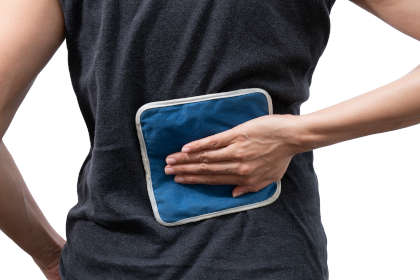Did you know that lower back pain is one of the most common health conditions affecting seniors, leading to pain, inflammation, and even disability?
MedBox: Never Sort Medications Again
But the good news is that back pain can be naturally manageable. In this article, we will discuss simple yet natural tips to reduce back pain for seniors.
Back pain may occur due to various reasons, including osteoarthritis, osteoporosis, poor posture, muscle spasms, stress, or carrying extra weight. Addressing the underlying issue and following a few self-care tips can help alleviate back pain naturally.
Three Common Reasons for Back Pain in Seniors and How To Identify Them
Here are three common reasons that may cause back pain and how you can identify them:
Osteoarthritis
Degenerative arthritis (“wear and tear” arthritis, or osteoarthritis) is a common joint disease that causes inflammation and pain in any of the joints. It commonly occurs in the joints of the spine, hips, knees, feet, and hands. If osteoarthritis affects your spine, it can result in chronic back pain.
If you experience back pain, stiffness, or reduced range of motion that worsens with activity, the back pain may be because of osteoarthritis. The pain is typically dull and achy but can occasionally be associated with sharp pains with certain movements. Tests like spine X-rays or MRIs can be helpful to confirm the diagnosis.
Sciatica
Another common reason for back pain that affects people of any age group, particularly seniors, is sciatica. Sciatica occurs due to compression of a nerve located in the lower back. This may be due to a herniation of a disc in the spine or from an abnormal bone spur growth. Sciatica pain frequently radiates from the back and extends to one or both sides of the legs.
If you experience tingling or a shocking or shooting sensation in your back that extends down to the legs or feet, or if there is numbness with back pain, it may be due to sciatica. Similar to osteoarthritis, a diagnosis of sciatica can be made from a physical exam with your doctor or with a spine x-ray or MRI.
Muscle Strain or Sprain
Muscle strains or sprains are another reason you may be experiencing back pain.
Our back is responsible for bearing much of our body weight, especially during activities like running, walking, or lifting. Some additional pressure or extra weight on the back can cause muscle strains, sprains, or injuries to the muscles or tendons.
Your back pain may be the result of a muscle strain or sprain if your back has gone through prolonged repetitive use, or if you have chronic poor posture or body mechanics while walking. You may also have a strain or sprain if you recently fell or twisted your back.
The common symptoms of muscle strains include back pain that increases with movement, muscle cramping, decreased range of motion, and occasionally localized swelling in the back.
No More Pill Sorting! Our Pharmacy Pre-Sorts and Packages Your Pills
4 Simple, Actionable Tips To Reduce Back Pain
The following are some simple and natural things you can do to help soothe your back pain:
1. Apply Ice Packs

Did you know that applying ice packs on the affected areas is one of the most effective ways to reduce back pain, inflammation, swelling, and bruising?
If you are experiencing pain with inflammation or swelling in the muscles, it may be a result of muscle strains, muscle injury, or arthritis. In these conditions, you can slowly massage your affected areas with ice packs for around 15 – 20 minutes two to three times per day or as required.
The benefits of using ice packs for back pain include the following:
- Ice packs help reduce swelling in your back by constricting the blood vessels, which decreases blood flow to the affected areas, reducing inflammation.
- Ice packs help relax muscles, providing overall relief from back pain.
- Ice packs temporarily numb the muscles or nerves that cause back pain, thus reducing pain sensations.
People with severe cardiovascular disease, nerve damage, poor circulation, open wounds or infection, hypersensitivity to cold, or other chronic diseases should avoid using ice packs or should consult their doctors before using them.
2. Apply Heat and Take Warm Baths
If you still experience pain after applying ice packs, you can try massaging the affected area with a warm cloth or heating pads and take warm baths.
You can also try switching between cold and heat massaging. Start with an ice pack massage for 15 to 20 minutes, and then after a couple of hours, massage with heat pads for 10 to 15 minutes.
Heat helps relax back muscles, loosen up stiff muscles, improve the range of motion of the lower back, and enhance blood flow to the affected areas. Using topical heat pads helps lessen both muscle spasms and stiffness. Ice and heat massaging can help relieve back pain caused by muscle strains, sprains, arthritis, and sciatica.
However, avoid using heat therapy if you have any skin conditions, like dermatitis, blood clots, open wounds, or peripheral vascular disease.
3. Avoid Weight Lifting or Other Strenuous Physical Activities
Weight lifting and other strenuous physical activities put additional pressure on your back and lead to backache. Moreover, as many seniors have a weak core due to advanced age, a slight increase in pressure on the back can contribute to developing back pain.
Hence, seniors with acute or chronic back pain should avoid all types of weight lifting and strenuous physical activities until they have clearance from their doctors.
4. Engage In Moderate Aerobic Activities or Physical Movement
While you should avoid weight lifting and extreme physical activities, it is still recommended to stay active and avoid strict bed rest.
Engaging in mild to moderate physical activities, like walking, swimming, gentle stretching, or some core strengthening exercises like leg raises, glute bridges, or others, should be done as they can help you recover more quickly from back pain. Not moving enough can actually weaken your muscle mass and make the pain worse over the long term, and result in other health issues from the inactivity.


